A Comparative Analysis: Strategic Choice and Environmental Determinism
VerifiedAdded on 2023/06/03
|10
|2901
|102
Essay
AI Summary
This essay provides a comparative analysis of strategic choice and environmental determinism theories in management. It explores the philosophical underpinnings, environmental views, and decision-making processes associated with each theory. The essay discusses structural contingency theory, resource dependency theory, institutional theory, and population ecology as elements of environmental determinism. It examines the strengths and weaknesses of both strategic choice and determinism, arguing that while strategic choice offers a more proactive role for managers, determinism highlights the constraints imposed by environmental factors. The essay concludes by considering factors that inhibit strategic choice and enhance the prevalence of determinism in organizational management, such as the limited role of leaders and the controlling influence of the environment.
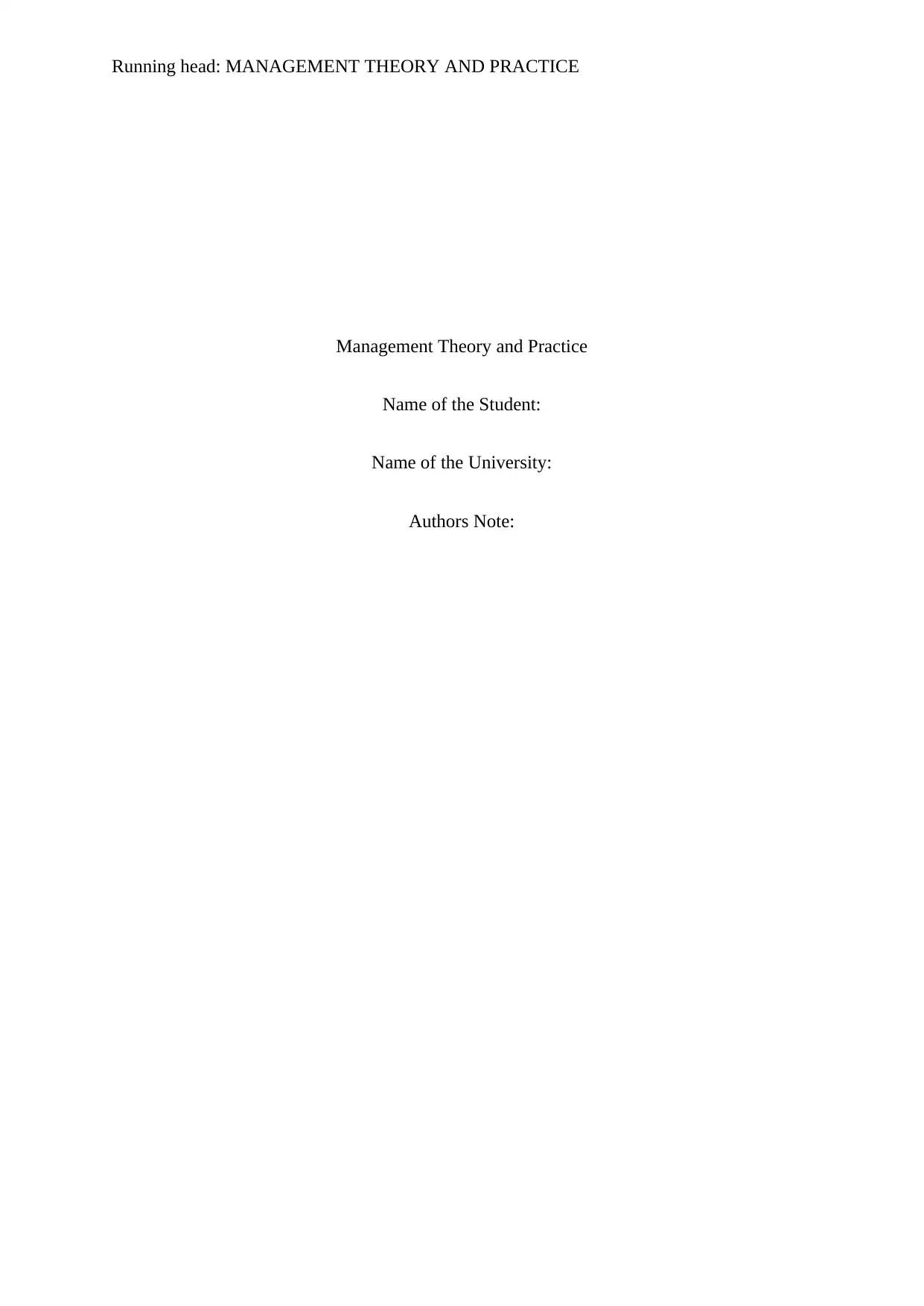
Running head: MANAGEMENT THEORY AND PRACTICE
Management Theory and Practice
Name of the Student:
Name of the University:
Authors Note:
Management Theory and Practice
Name of the Student:
Name of the University:
Authors Note:
Paraphrase This Document
Need a fresh take? Get an instant paraphrase of this document with our AI Paraphraser
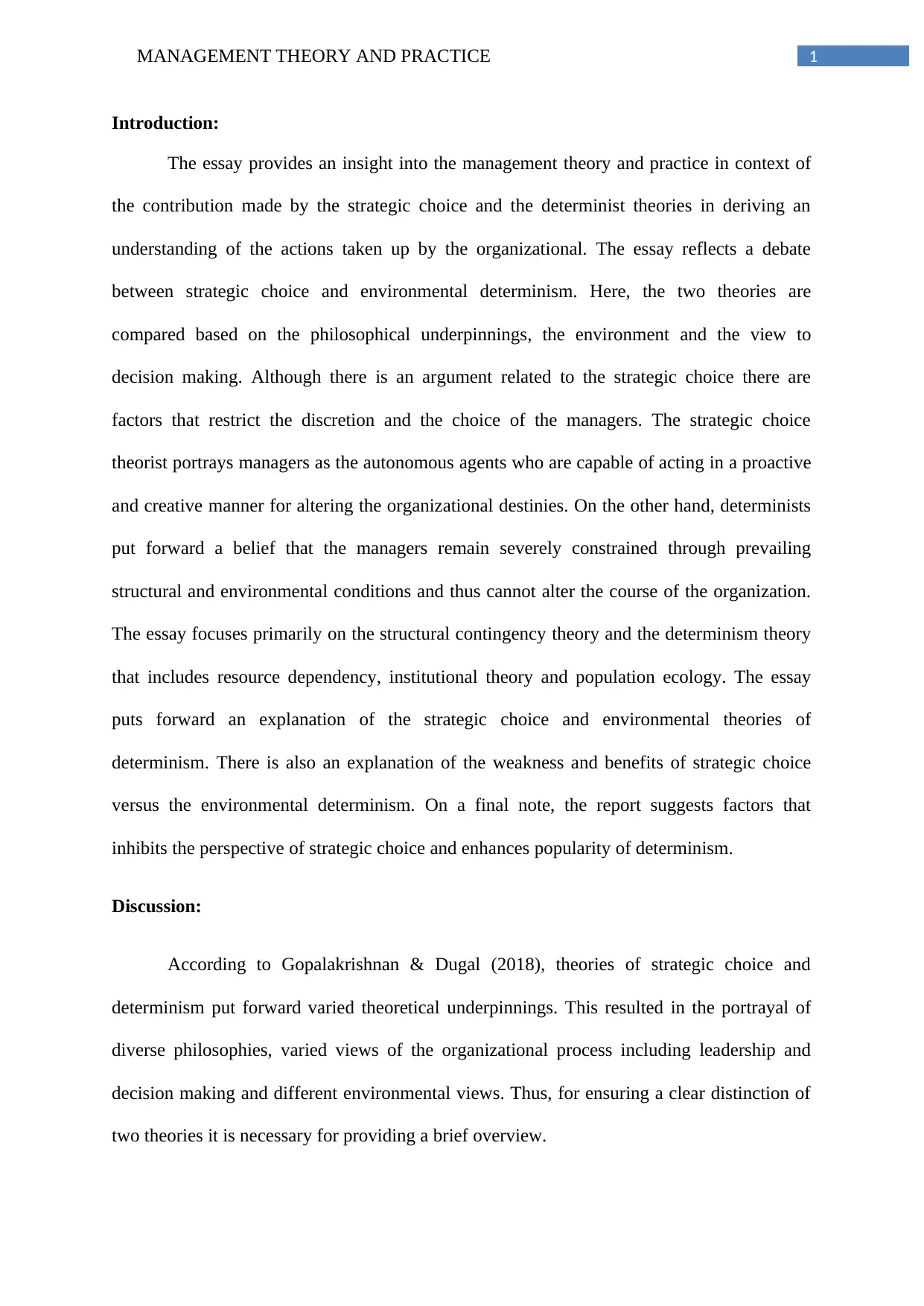
1MANAGEMENT THEORY AND PRACTICE
Introduction:
The essay provides an insight into the management theory and practice in context of
the contribution made by the strategic choice and the determinist theories in deriving an
understanding of the actions taken up by the organizational. The essay reflects a debate
between strategic choice and environmental determinism. Here, the two theories are
compared based on the philosophical underpinnings, the environment and the view to
decision making. Although there is an argument related to the strategic choice there are
factors that restrict the discretion and the choice of the managers. The strategic choice
theorist portrays managers as the autonomous agents who are capable of acting in a proactive
and creative manner for altering the organizational destinies. On the other hand, determinists
put forward a belief that the managers remain severely constrained through prevailing
structural and environmental conditions and thus cannot alter the course of the organization.
The essay focuses primarily on the structural contingency theory and the determinism theory
that includes resource dependency, institutional theory and population ecology. The essay
puts forward an explanation of the strategic choice and environmental theories of
determinism. There is also an explanation of the weakness and benefits of strategic choice
versus the environmental determinism. On a final note, the report suggests factors that
inhibits the perspective of strategic choice and enhances popularity of determinism.
Discussion:
According to Gopalakrishnan & Dugal (2018), theories of strategic choice and
determinism put forward varied theoretical underpinnings. This resulted in the portrayal of
diverse philosophies, varied views of the organizational process including leadership and
decision making and different environmental views. Thus, for ensuring a clear distinction of
two theories it is necessary for providing a brief overview.
Introduction:
The essay provides an insight into the management theory and practice in context of
the contribution made by the strategic choice and the determinist theories in deriving an
understanding of the actions taken up by the organizational. The essay reflects a debate
between strategic choice and environmental determinism. Here, the two theories are
compared based on the philosophical underpinnings, the environment and the view to
decision making. Although there is an argument related to the strategic choice there are
factors that restrict the discretion and the choice of the managers. The strategic choice
theorist portrays managers as the autonomous agents who are capable of acting in a proactive
and creative manner for altering the organizational destinies. On the other hand, determinists
put forward a belief that the managers remain severely constrained through prevailing
structural and environmental conditions and thus cannot alter the course of the organization.
The essay focuses primarily on the structural contingency theory and the determinism theory
that includes resource dependency, institutional theory and population ecology. The essay
puts forward an explanation of the strategic choice and environmental theories of
determinism. There is also an explanation of the weakness and benefits of strategic choice
versus the environmental determinism. On a final note, the report suggests factors that
inhibits the perspective of strategic choice and enhances popularity of determinism.
Discussion:
According to Gopalakrishnan & Dugal (2018), theories of strategic choice and
determinism put forward varied theoretical underpinnings. This resulted in the portrayal of
diverse philosophies, varied views of the organizational process including leadership and
decision making and different environmental views. Thus, for ensuring a clear distinction of
two theories it is necessary for providing a brief overview.
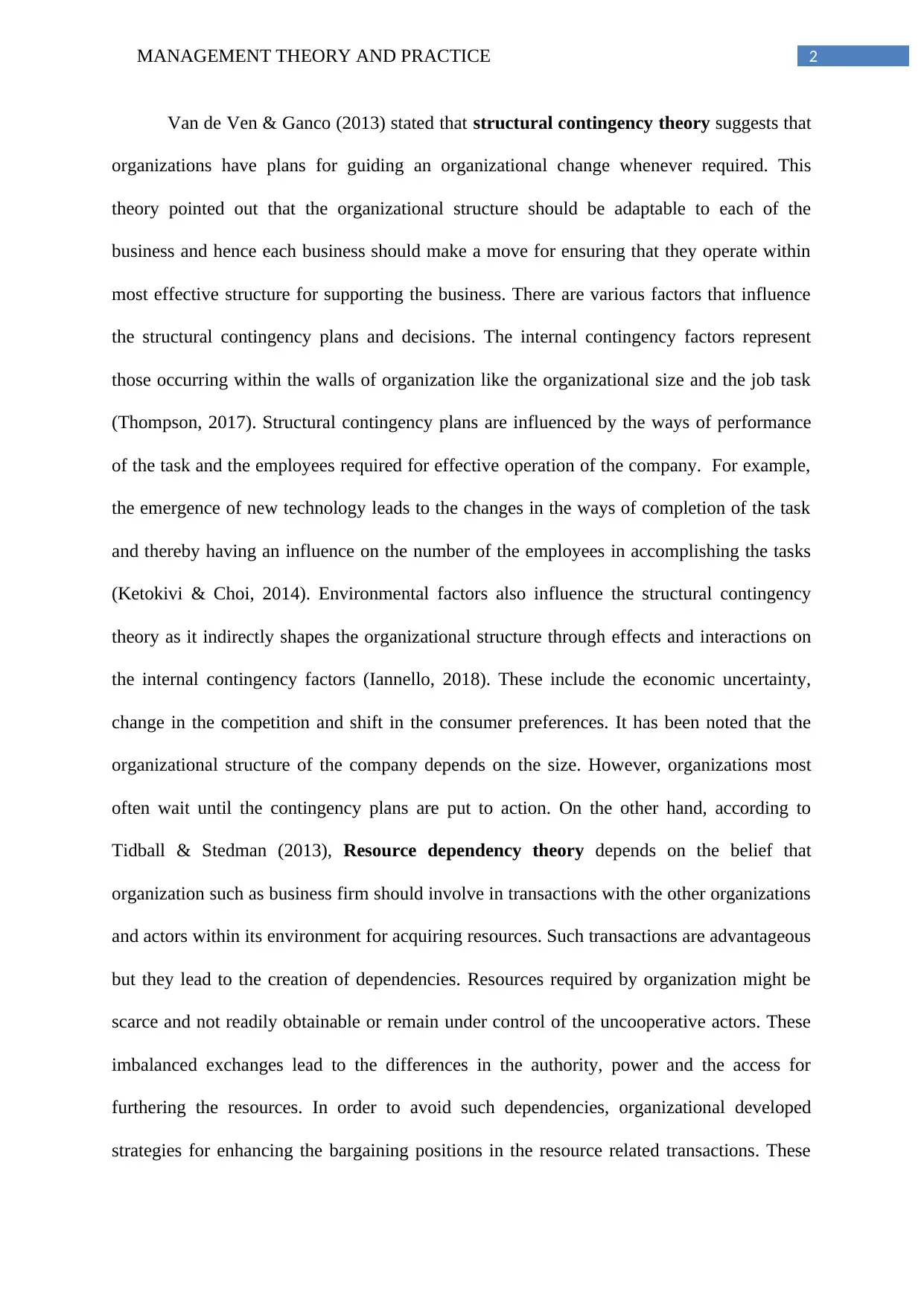
2MANAGEMENT THEORY AND PRACTICE
Van de Ven & Ganco (2013) stated that structural contingency theory suggests that
organizations have plans for guiding an organizational change whenever required. This
theory pointed out that the organizational structure should be adaptable to each of the
business and hence each business should make a move for ensuring that they operate within
most effective structure for supporting the business. There are various factors that influence
the structural contingency plans and decisions. The internal contingency factors represent
those occurring within the walls of organization like the organizational size and the job task
(Thompson, 2017). Structural contingency plans are influenced by the ways of performance
of the task and the employees required for effective operation of the company. For example,
the emergence of new technology leads to the changes in the ways of completion of the task
and thereby having an influence on the number of the employees in accomplishing the tasks
(Ketokivi & Choi, 2014). Environmental factors also influence the structural contingency
theory as it indirectly shapes the organizational structure through effects and interactions on
the internal contingency factors (Iannello, 2018). These include the economic uncertainty,
change in the competition and shift in the consumer preferences. It has been noted that the
organizational structure of the company depends on the size. However, organizations most
often wait until the contingency plans are put to action. On the other hand, according to
Tidball & Stedman (2013), Resource dependency theory depends on the belief that
organization such as business firm should involve in transactions with the other organizations
and actors within its environment for acquiring resources. Such transactions are advantageous
but they lead to the creation of dependencies. Resources required by organization might be
scarce and not readily obtainable or remain under control of the uncooperative actors. These
imbalanced exchanges lead to the differences in the authority, power and the access for
furthering the resources. In order to avoid such dependencies, organizational developed
strategies for enhancing the bargaining positions in the resource related transactions. These
Van de Ven & Ganco (2013) stated that structural contingency theory suggests that
organizations have plans for guiding an organizational change whenever required. This
theory pointed out that the organizational structure should be adaptable to each of the
business and hence each business should make a move for ensuring that they operate within
most effective structure for supporting the business. There are various factors that influence
the structural contingency plans and decisions. The internal contingency factors represent
those occurring within the walls of organization like the organizational size and the job task
(Thompson, 2017). Structural contingency plans are influenced by the ways of performance
of the task and the employees required for effective operation of the company. For example,
the emergence of new technology leads to the changes in the ways of completion of the task
and thereby having an influence on the number of the employees in accomplishing the tasks
(Ketokivi & Choi, 2014). Environmental factors also influence the structural contingency
theory as it indirectly shapes the organizational structure through effects and interactions on
the internal contingency factors (Iannello, 2018). These include the economic uncertainty,
change in the competition and shift in the consumer preferences. It has been noted that the
organizational structure of the company depends on the size. However, organizations most
often wait until the contingency plans are put to action. On the other hand, according to
Tidball & Stedman (2013), Resource dependency theory depends on the belief that
organization such as business firm should involve in transactions with the other organizations
and actors within its environment for acquiring resources. Such transactions are advantageous
but they lead to the creation of dependencies. Resources required by organization might be
scarce and not readily obtainable or remain under control of the uncooperative actors. These
imbalanced exchanges lead to the differences in the authority, power and the access for
furthering the resources. In order to avoid such dependencies, organizational developed
strategies for enhancing the bargaining positions in the resource related transactions. These
⊘ This is a preview!⊘
Do you want full access?
Subscribe today to unlock all pages.

Trusted by 1+ million students worldwide
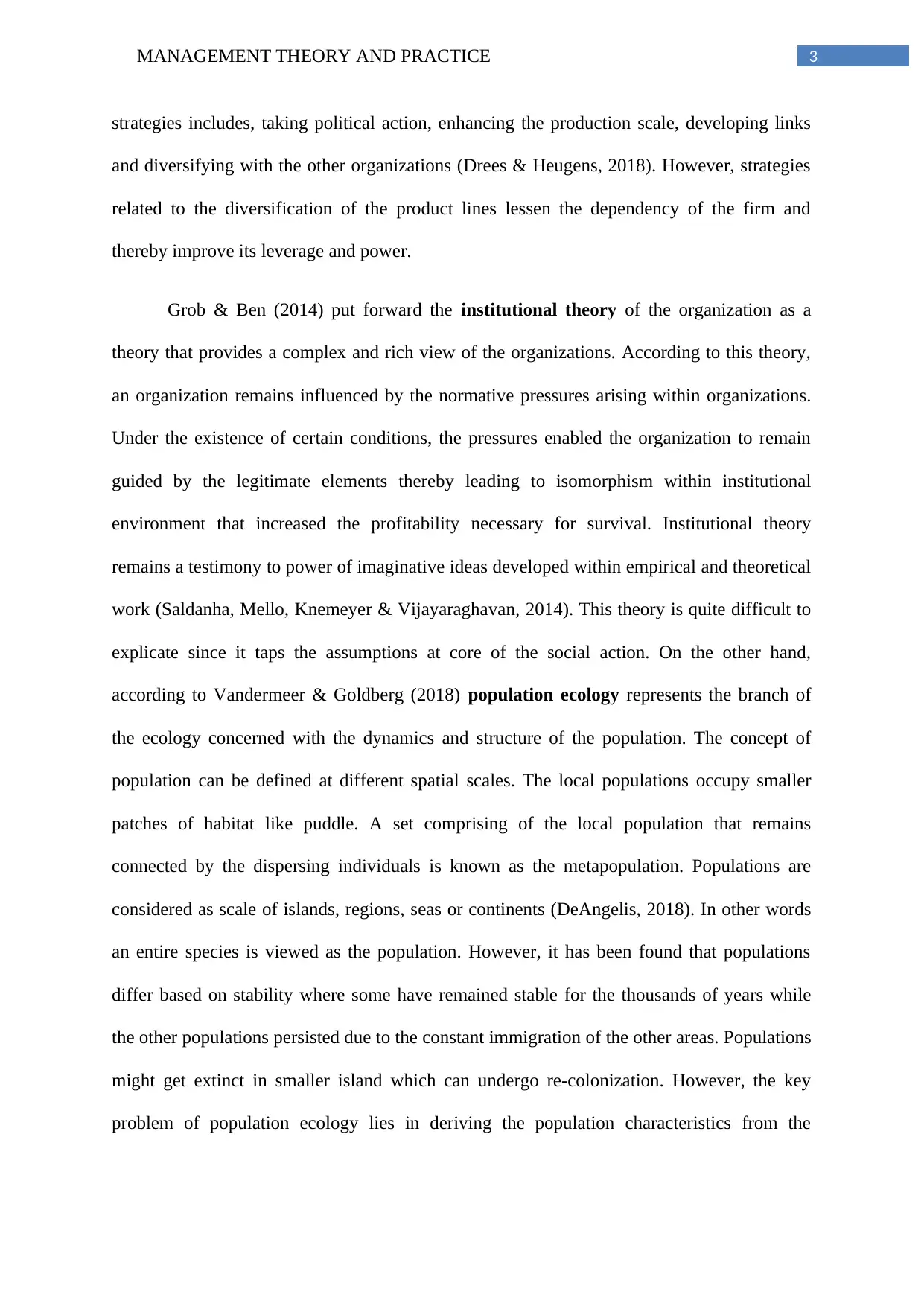
3MANAGEMENT THEORY AND PRACTICE
strategies includes, taking political action, enhancing the production scale, developing links
and diversifying with the other organizations (Drees & Heugens, 2018). However, strategies
related to the diversification of the product lines lessen the dependency of the firm and
thereby improve its leverage and power.
Grob & Ben (2014) put forward the institutional theory of the organization as a
theory that provides a complex and rich view of the organizations. According to this theory,
an organization remains influenced by the normative pressures arising within organizations.
Under the existence of certain conditions, the pressures enabled the organization to remain
guided by the legitimate elements thereby leading to isomorphism within institutional
environment that increased the profitability necessary for survival. Institutional theory
remains a testimony to power of imaginative ideas developed within empirical and theoretical
work (Saldanha, Mello, Knemeyer & Vijayaraghavan, 2014). This theory is quite difficult to
explicate since it taps the assumptions at core of the social action. On the other hand,
according to Vandermeer & Goldberg (2018) population ecology represents the branch of
the ecology concerned with the dynamics and structure of the population. The concept of
population can be defined at different spatial scales. The local populations occupy smaller
patches of habitat like puddle. A set comprising of the local population that remains
connected by the dispersing individuals is known as the metapopulation. Populations are
considered as scale of islands, regions, seas or continents (DeAngelis, 2018). In other words
an entire species is viewed as the population. However, it has been found that populations
differ based on stability where some have remained stable for the thousands of years while
the other populations persisted due to the constant immigration of the other areas. Populations
might get extinct in smaller island which can undergo re-colonization. However, the key
problem of population ecology lies in deriving the population characteristics from the
strategies includes, taking political action, enhancing the production scale, developing links
and diversifying with the other organizations (Drees & Heugens, 2018). However, strategies
related to the diversification of the product lines lessen the dependency of the firm and
thereby improve its leverage and power.
Grob & Ben (2014) put forward the institutional theory of the organization as a
theory that provides a complex and rich view of the organizations. According to this theory,
an organization remains influenced by the normative pressures arising within organizations.
Under the existence of certain conditions, the pressures enabled the organization to remain
guided by the legitimate elements thereby leading to isomorphism within institutional
environment that increased the profitability necessary for survival. Institutional theory
remains a testimony to power of imaginative ideas developed within empirical and theoretical
work (Saldanha, Mello, Knemeyer & Vijayaraghavan, 2014). This theory is quite difficult to
explicate since it taps the assumptions at core of the social action. On the other hand,
according to Vandermeer & Goldberg (2018) population ecology represents the branch of
the ecology concerned with the dynamics and structure of the population. The concept of
population can be defined at different spatial scales. The local populations occupy smaller
patches of habitat like puddle. A set comprising of the local population that remains
connected by the dispersing individuals is known as the metapopulation. Populations are
considered as scale of islands, regions, seas or continents (DeAngelis, 2018). In other words
an entire species is viewed as the population. However, it has been found that populations
differ based on stability where some have remained stable for the thousands of years while
the other populations persisted due to the constant immigration of the other areas. Populations
might get extinct in smaller island which can undergo re-colonization. However, the key
problem of population ecology lies in deriving the population characteristics from the
Paraphrase This Document
Need a fresh take? Get an instant paraphrase of this document with our AI Paraphraser
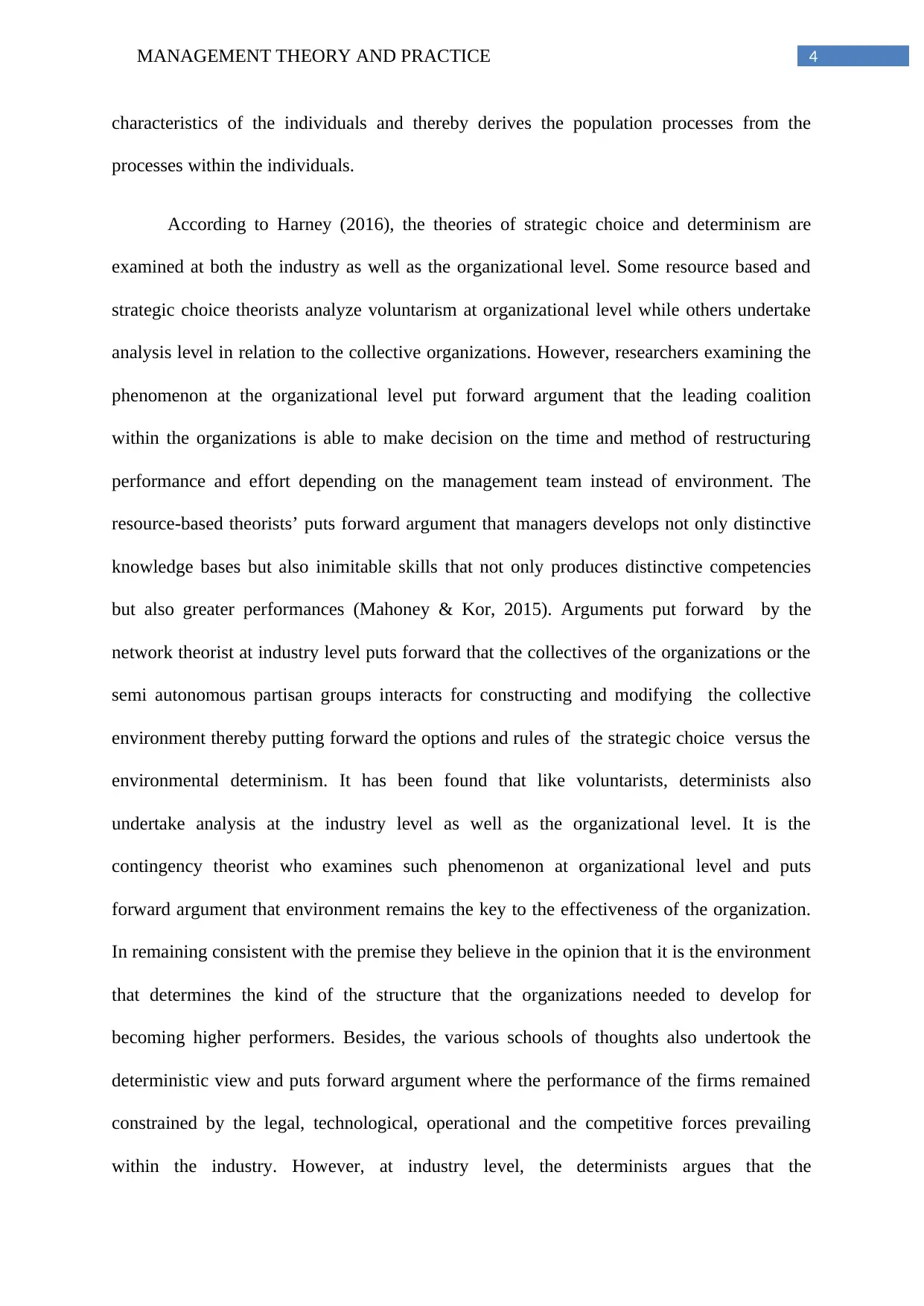
4MANAGEMENT THEORY AND PRACTICE
characteristics of the individuals and thereby derives the population processes from the
processes within the individuals.
According to Harney (2016), the theories of strategic choice and determinism are
examined at both the industry as well as the organizational level. Some resource based and
strategic choice theorists analyze voluntarism at organizational level while others undertake
analysis level in relation to the collective organizations. However, researchers examining the
phenomenon at the organizational level put forward argument that the leading coalition
within the organizations is able to make decision on the time and method of restructuring
performance and effort depending on the management team instead of environment. The
resource-based theorists’ puts forward argument that managers develops not only distinctive
knowledge bases but also inimitable skills that not only produces distinctive competencies
but also greater performances (Mahoney & Kor, 2015). Arguments put forward by the
network theorist at industry level puts forward that the collectives of the organizations or the
semi autonomous partisan groups interacts for constructing and modifying the collective
environment thereby putting forward the options and rules of the strategic choice versus the
environmental determinism. It has been found that like voluntarists, determinists also
undertake analysis at the industry level as well as the organizational level. It is the
contingency theorist who examines such phenomenon at organizational level and puts
forward argument that environment remains the key to the effectiveness of the organization.
In remaining consistent with the premise they believe in the opinion that it is the environment
that determines the kind of the structure that the organizations needed to develop for
becoming higher performers. Besides, the various schools of thoughts also undertook the
deterministic view and puts forward argument where the performance of the firms remained
constrained by the legal, technological, operational and the competitive forces prevailing
within the industry. However, at industry level, the determinists argues that the
characteristics of the individuals and thereby derives the population processes from the
processes within the individuals.
According to Harney (2016), the theories of strategic choice and determinism are
examined at both the industry as well as the organizational level. Some resource based and
strategic choice theorists analyze voluntarism at organizational level while others undertake
analysis level in relation to the collective organizations. However, researchers examining the
phenomenon at the organizational level put forward argument that the leading coalition
within the organizations is able to make decision on the time and method of restructuring
performance and effort depending on the management team instead of environment. The
resource-based theorists’ puts forward argument that managers develops not only distinctive
knowledge bases but also inimitable skills that not only produces distinctive competencies
but also greater performances (Mahoney & Kor, 2015). Arguments put forward by the
network theorist at industry level puts forward that the collectives of the organizations or the
semi autonomous partisan groups interacts for constructing and modifying the collective
environment thereby putting forward the options and rules of the strategic choice versus the
environmental determinism. It has been found that like voluntarists, determinists also
undertake analysis at the industry level as well as the organizational level. It is the
contingency theorist who examines such phenomenon at organizational level and puts
forward argument that environment remains the key to the effectiveness of the organization.
In remaining consistent with the premise they believe in the opinion that it is the environment
that determines the kind of the structure that the organizations needed to develop for
becoming higher performers. Besides, the various schools of thoughts also undertook the
deterministic view and puts forward argument where the performance of the firms remained
constrained by the legal, technological, operational and the competitive forces prevailing
within the industry. However, at industry level, the determinists argues that the
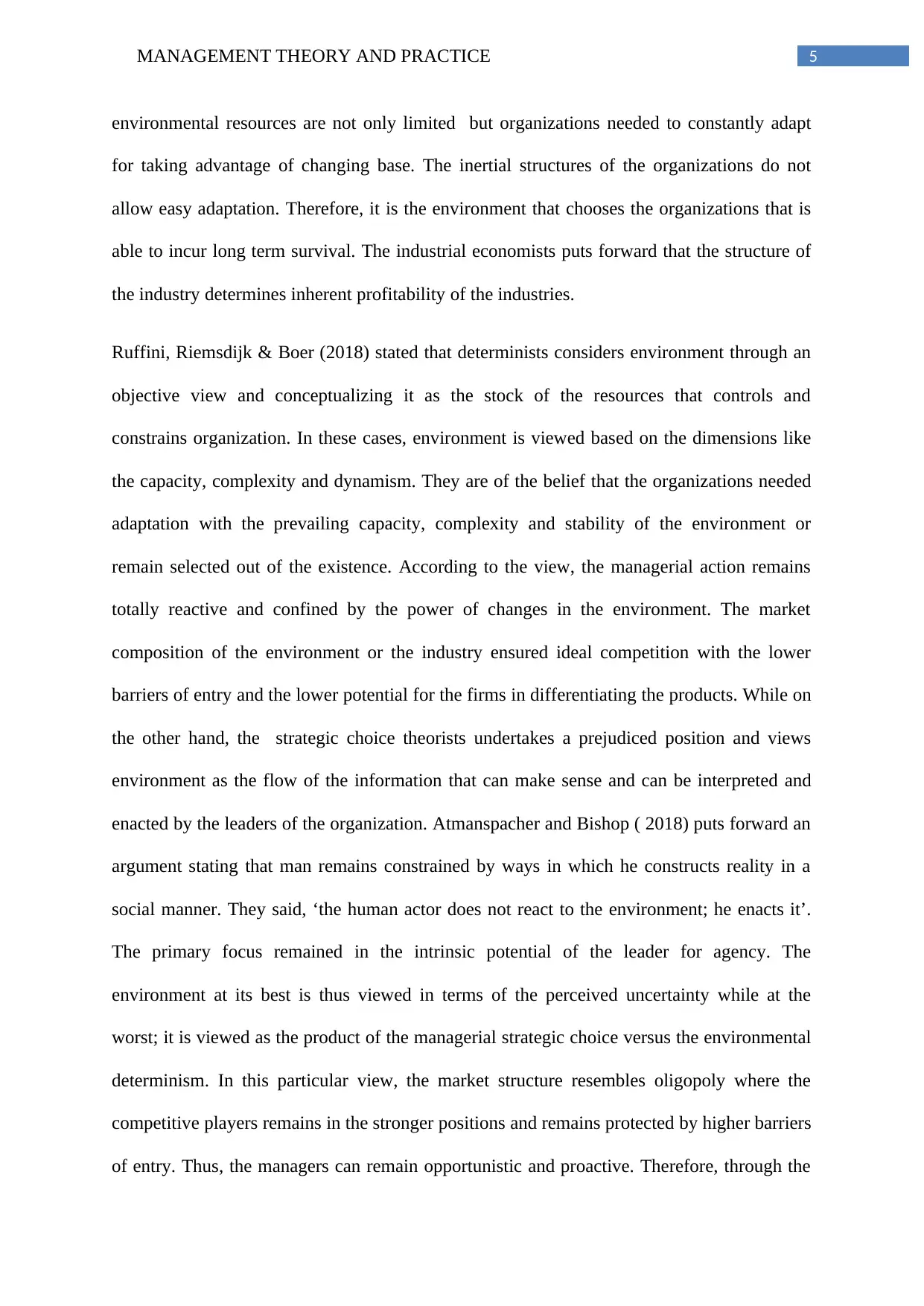
5MANAGEMENT THEORY AND PRACTICE
environmental resources are not only limited but organizations needed to constantly adapt
for taking advantage of changing base. The inertial structures of the organizations do not
allow easy adaptation. Therefore, it is the environment that chooses the organizations that is
able to incur long term survival. The industrial economists puts forward that the structure of
the industry determines inherent profitability of the industries.
Ruffini, Riemsdijk & Boer (2018) stated that determinists considers environment through an
objective view and conceptualizing it as the stock of the resources that controls and
constrains organization. In these cases, environment is viewed based on the dimensions like
the capacity, complexity and dynamism. They are of the belief that the organizations needed
adaptation with the prevailing capacity, complexity and stability of the environment or
remain selected out of the existence. According to the view, the managerial action remains
totally reactive and confined by the power of changes in the environment. The market
composition of the environment or the industry ensured ideal competition with the lower
barriers of entry and the lower potential for the firms in differentiating the products. While on
the other hand, the strategic choice theorists undertakes a prejudiced position and views
environment as the flow of the information that can make sense and can be interpreted and
enacted by the leaders of the organization. Atmanspacher and Bishop ( 2018) puts forward an
argument stating that man remains constrained by ways in which he constructs reality in a
social manner. They said, ‘the human actor does not react to the environment; he enacts it’.
The primary focus remained in the intrinsic potential of the leader for agency. The
environment at its best is thus viewed in terms of the perceived uncertainty while at the
worst; it is viewed as the product of the managerial strategic choice versus the environmental
determinism. In this particular view, the market structure resembles oligopoly where the
competitive players remains in the stronger positions and remains protected by higher barriers
of entry. Thus, the managers can remain opportunistic and proactive. Therefore, through the
environmental resources are not only limited but organizations needed to constantly adapt
for taking advantage of changing base. The inertial structures of the organizations do not
allow easy adaptation. Therefore, it is the environment that chooses the organizations that is
able to incur long term survival. The industrial economists puts forward that the structure of
the industry determines inherent profitability of the industries.
Ruffini, Riemsdijk & Boer (2018) stated that determinists considers environment through an
objective view and conceptualizing it as the stock of the resources that controls and
constrains organization. In these cases, environment is viewed based on the dimensions like
the capacity, complexity and dynamism. They are of the belief that the organizations needed
adaptation with the prevailing capacity, complexity and stability of the environment or
remain selected out of the existence. According to the view, the managerial action remains
totally reactive and confined by the power of changes in the environment. The market
composition of the environment or the industry ensured ideal competition with the lower
barriers of entry and the lower potential for the firms in differentiating the products. While on
the other hand, the strategic choice theorists undertakes a prejudiced position and views
environment as the flow of the information that can make sense and can be interpreted and
enacted by the leaders of the organization. Atmanspacher and Bishop ( 2018) puts forward an
argument stating that man remains constrained by ways in which he constructs reality in a
social manner. They said, ‘the human actor does not react to the environment; he enacts it’.
The primary focus remained in the intrinsic potential of the leader for agency. The
environment at its best is thus viewed in terms of the perceived uncertainty while at the
worst; it is viewed as the product of the managerial strategic choice versus the environmental
determinism. In this particular view, the market structure resembles oligopoly where the
competitive players remains in the stronger positions and remains protected by higher barriers
of entry. Thus, the managers can remain opportunistic and proactive. Therefore, through the
⊘ This is a preview!⊘
Do you want full access?
Subscribe today to unlock all pages.

Trusted by 1+ million students worldwide
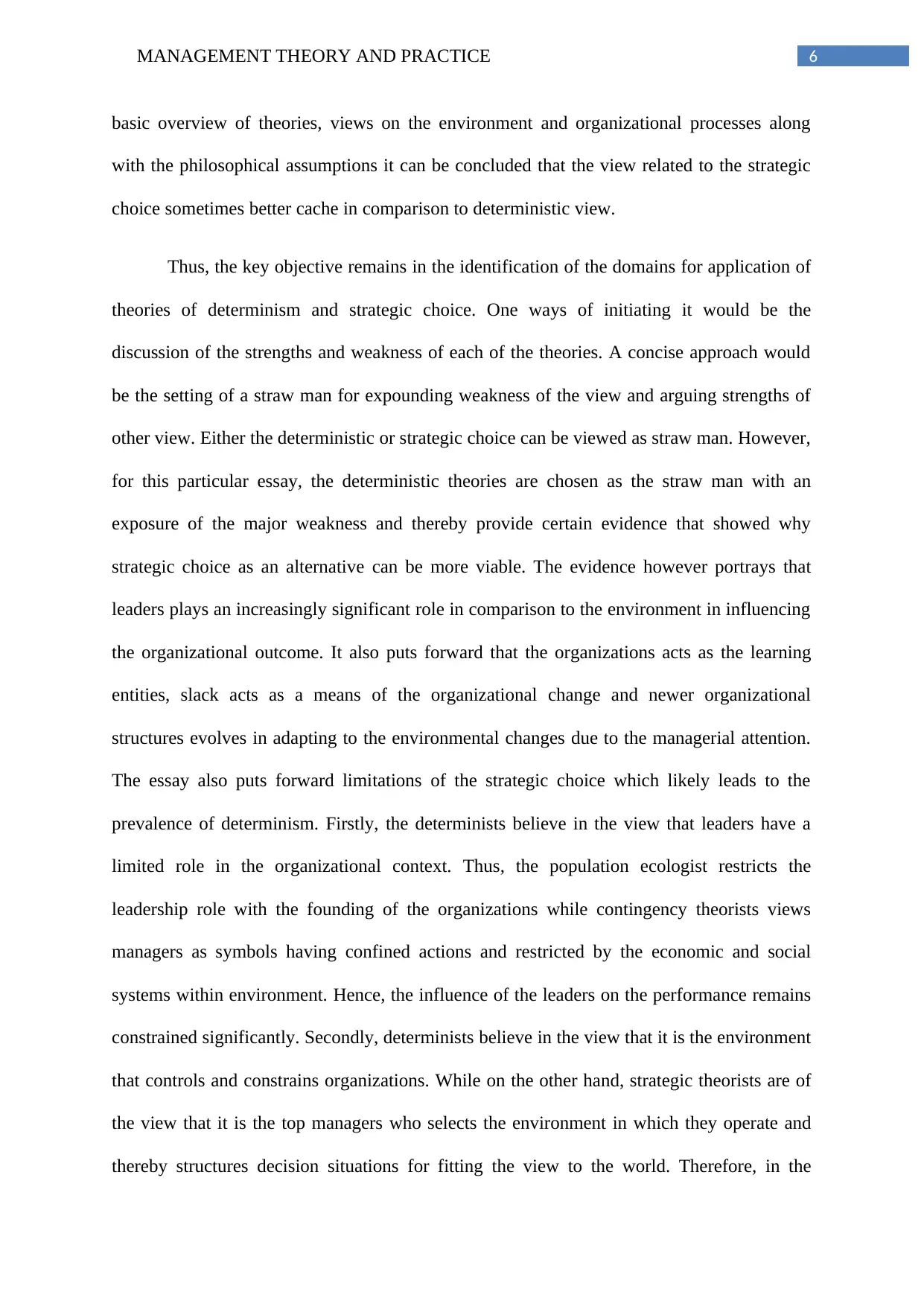
6MANAGEMENT THEORY AND PRACTICE
basic overview of theories, views on the environment and organizational processes along
with the philosophical assumptions it can be concluded that the view related to the strategic
choice sometimes better cache in comparison to deterministic view.
Thus, the key objective remains in the identification of the domains for application of
theories of determinism and strategic choice. One ways of initiating it would be the
discussion of the strengths and weakness of each of the theories. A concise approach would
be the setting of a straw man for expounding weakness of the view and arguing strengths of
other view. Either the deterministic or strategic choice can be viewed as straw man. However,
for this particular essay, the deterministic theories are chosen as the straw man with an
exposure of the major weakness and thereby provide certain evidence that showed why
strategic choice as an alternative can be more viable. The evidence however portrays that
leaders plays an increasingly significant role in comparison to the environment in influencing
the organizational outcome. It also puts forward that the organizations acts as the learning
entities, slack acts as a means of the organizational change and newer organizational
structures evolves in adapting to the environmental changes due to the managerial attention.
The essay also puts forward limitations of the strategic choice which likely leads to the
prevalence of determinism. Firstly, the determinists believe in the view that leaders have a
limited role in the organizational context. Thus, the population ecologist restricts the
leadership role with the founding of the organizations while contingency theorists views
managers as symbols having confined actions and restricted by the economic and social
systems within environment. Hence, the influence of the leaders on the performance remains
constrained significantly. Secondly, determinists believe in the view that it is the environment
that controls and constrains organizations. While on the other hand, strategic theorists are of
the view that it is the top managers who selects the environment in which they operate and
thereby structures decision situations for fitting the view to the world. Therefore, in the
basic overview of theories, views on the environment and organizational processes along
with the philosophical assumptions it can be concluded that the view related to the strategic
choice sometimes better cache in comparison to deterministic view.
Thus, the key objective remains in the identification of the domains for application of
theories of determinism and strategic choice. One ways of initiating it would be the
discussion of the strengths and weakness of each of the theories. A concise approach would
be the setting of a straw man for expounding weakness of the view and arguing strengths of
other view. Either the deterministic or strategic choice can be viewed as straw man. However,
for this particular essay, the deterministic theories are chosen as the straw man with an
exposure of the major weakness and thereby provide certain evidence that showed why
strategic choice as an alternative can be more viable. The evidence however portrays that
leaders plays an increasingly significant role in comparison to the environment in influencing
the organizational outcome. It also puts forward that the organizations acts as the learning
entities, slack acts as a means of the organizational change and newer organizational
structures evolves in adapting to the environmental changes due to the managerial attention.
The essay also puts forward limitations of the strategic choice which likely leads to the
prevalence of determinism. Firstly, the determinists believe in the view that leaders have a
limited role in the organizational context. Thus, the population ecologist restricts the
leadership role with the founding of the organizations while contingency theorists views
managers as symbols having confined actions and restricted by the economic and social
systems within environment. Hence, the influence of the leaders on the performance remains
constrained significantly. Secondly, determinists believe in the view that it is the environment
that controls and constrains organizations. While on the other hand, strategic theorists are of
the view that it is the top managers who selects the environment in which they operate and
thereby structures decision situations for fitting the view to the world. Therefore, in the
Paraphrase This Document
Need a fresh take? Get an instant paraphrase of this document with our AI Paraphraser
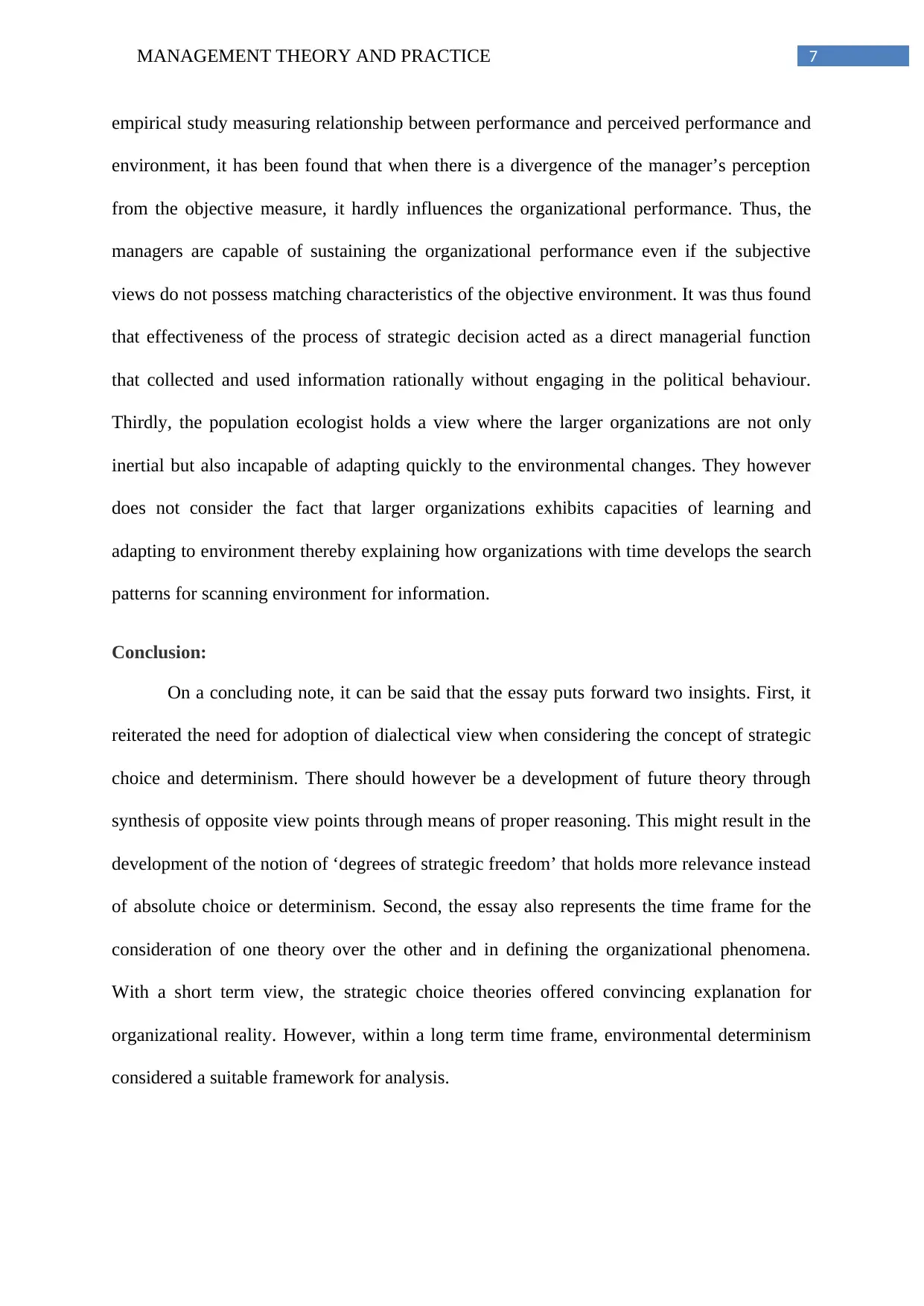
7MANAGEMENT THEORY AND PRACTICE
empirical study measuring relationship between performance and perceived performance and
environment, it has been found that when there is a divergence of the manager’s perception
from the objective measure, it hardly influences the organizational performance. Thus, the
managers are capable of sustaining the organizational performance even if the subjective
views do not possess matching characteristics of the objective environment. It was thus found
that effectiveness of the process of strategic decision acted as a direct managerial function
that collected and used information rationally without engaging in the political behaviour.
Thirdly, the population ecologist holds a view where the larger organizations are not only
inertial but also incapable of adapting quickly to the environmental changes. They however
does not consider the fact that larger organizations exhibits capacities of learning and
adapting to environment thereby explaining how organizations with time develops the search
patterns for scanning environment for information.
Conclusion:
On a concluding note, it can be said that the essay puts forward two insights. First, it
reiterated the need for adoption of dialectical view when considering the concept of strategic
choice and determinism. There should however be a development of future theory through
synthesis of opposite view points through means of proper reasoning. This might result in the
development of the notion of ‘degrees of strategic freedom’ that holds more relevance instead
of absolute choice or determinism. Second, the essay also represents the time frame for the
consideration of one theory over the other and in defining the organizational phenomena.
With a short term view, the strategic choice theories offered convincing explanation for
organizational reality. However, within a long term time frame, environmental determinism
considered a suitable framework for analysis.
empirical study measuring relationship between performance and perceived performance and
environment, it has been found that when there is a divergence of the manager’s perception
from the objective measure, it hardly influences the organizational performance. Thus, the
managers are capable of sustaining the organizational performance even if the subjective
views do not possess matching characteristics of the objective environment. It was thus found
that effectiveness of the process of strategic decision acted as a direct managerial function
that collected and used information rationally without engaging in the political behaviour.
Thirdly, the population ecologist holds a view where the larger organizations are not only
inertial but also incapable of adapting quickly to the environmental changes. They however
does not consider the fact that larger organizations exhibits capacities of learning and
adapting to environment thereby explaining how organizations with time develops the search
patterns for scanning environment for information.
Conclusion:
On a concluding note, it can be said that the essay puts forward two insights. First, it
reiterated the need for adoption of dialectical view when considering the concept of strategic
choice and determinism. There should however be a development of future theory through
synthesis of opposite view points through means of proper reasoning. This might result in the
development of the notion of ‘degrees of strategic freedom’ that holds more relevance instead
of absolute choice or determinism. Second, the essay also represents the time frame for the
consideration of one theory over the other and in defining the organizational phenomena.
With a short term view, the strategic choice theories offered convincing explanation for
organizational reality. However, within a long term time frame, environmental determinism
considered a suitable framework for analysis.
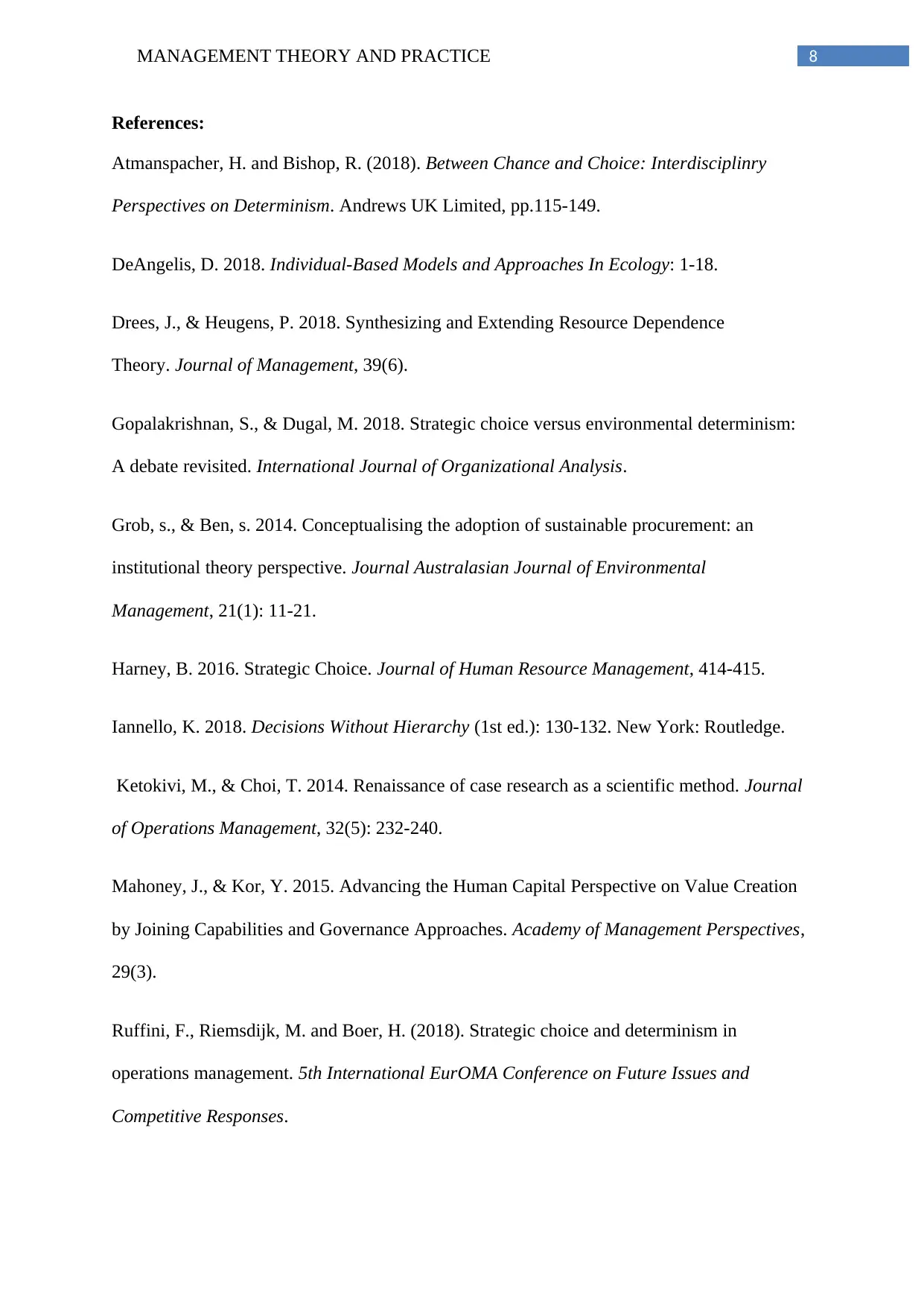
8MANAGEMENT THEORY AND PRACTICE
References:
Atmanspacher, H. and Bishop, R. (2018). Between Chance and Choice: Interdisciplinry
Perspectives on Determinism. Andrews UK Limited, pp.115-149.
DeAngelis, D. 2018. Individual-Based Models and Approaches In Ecology: 1-18.
Drees, J., & Heugens, P. 2018. Synthesizing and Extending Resource Dependence
Theory. Journal of Management, 39(6).
Gopalakrishnan, S., & Dugal, M. 2018. Strategic choice versus environmental determinism:
A debate revisited. International Journal of Organizational Analysis.
Grob, s., & Ben, s. 2014. Conceptualising the adoption of sustainable procurement: an
institutional theory perspective. Journal Australasian Journal of Environmental
Management, 21(1): 11-21.
Harney, B. 2016. Strategic Choice. Journal of Human Resource Management, 414-415.
Iannello, K. 2018. Decisions Without Hierarchy (1st ed.): 130-132. New York: Routledge.
Ketokivi, M., & Choi, T. 2014. Renaissance of case research as a scientific method. Journal
of Operations Management, 32(5): 232-240.
Mahoney, J., & Kor, Y. 2015. Advancing the Human Capital Perspective on Value Creation
by Joining Capabilities and Governance Approaches. Academy of Management Perspectives,
29(3).
Ruffini, F., Riemsdijk, M. and Boer, H. (2018). Strategic choice and determinism in
operations management. 5th International EurOMA Conference on Future Issues and
Competitive Responses.
References:
Atmanspacher, H. and Bishop, R. (2018). Between Chance and Choice: Interdisciplinry
Perspectives on Determinism. Andrews UK Limited, pp.115-149.
DeAngelis, D. 2018. Individual-Based Models and Approaches In Ecology: 1-18.
Drees, J., & Heugens, P. 2018. Synthesizing and Extending Resource Dependence
Theory. Journal of Management, 39(6).
Gopalakrishnan, S., & Dugal, M. 2018. Strategic choice versus environmental determinism:
A debate revisited. International Journal of Organizational Analysis.
Grob, s., & Ben, s. 2014. Conceptualising the adoption of sustainable procurement: an
institutional theory perspective. Journal Australasian Journal of Environmental
Management, 21(1): 11-21.
Harney, B. 2016. Strategic Choice. Journal of Human Resource Management, 414-415.
Iannello, K. 2018. Decisions Without Hierarchy (1st ed.): 130-132. New York: Routledge.
Ketokivi, M., & Choi, T. 2014. Renaissance of case research as a scientific method. Journal
of Operations Management, 32(5): 232-240.
Mahoney, J., & Kor, Y. 2015. Advancing the Human Capital Perspective on Value Creation
by Joining Capabilities and Governance Approaches. Academy of Management Perspectives,
29(3).
Ruffini, F., Riemsdijk, M. and Boer, H. (2018). Strategic choice and determinism in
operations management. 5th International EurOMA Conference on Future Issues and
Competitive Responses.
⊘ This is a preview!⊘
Do you want full access?
Subscribe today to unlock all pages.

Trusted by 1+ million students worldwide
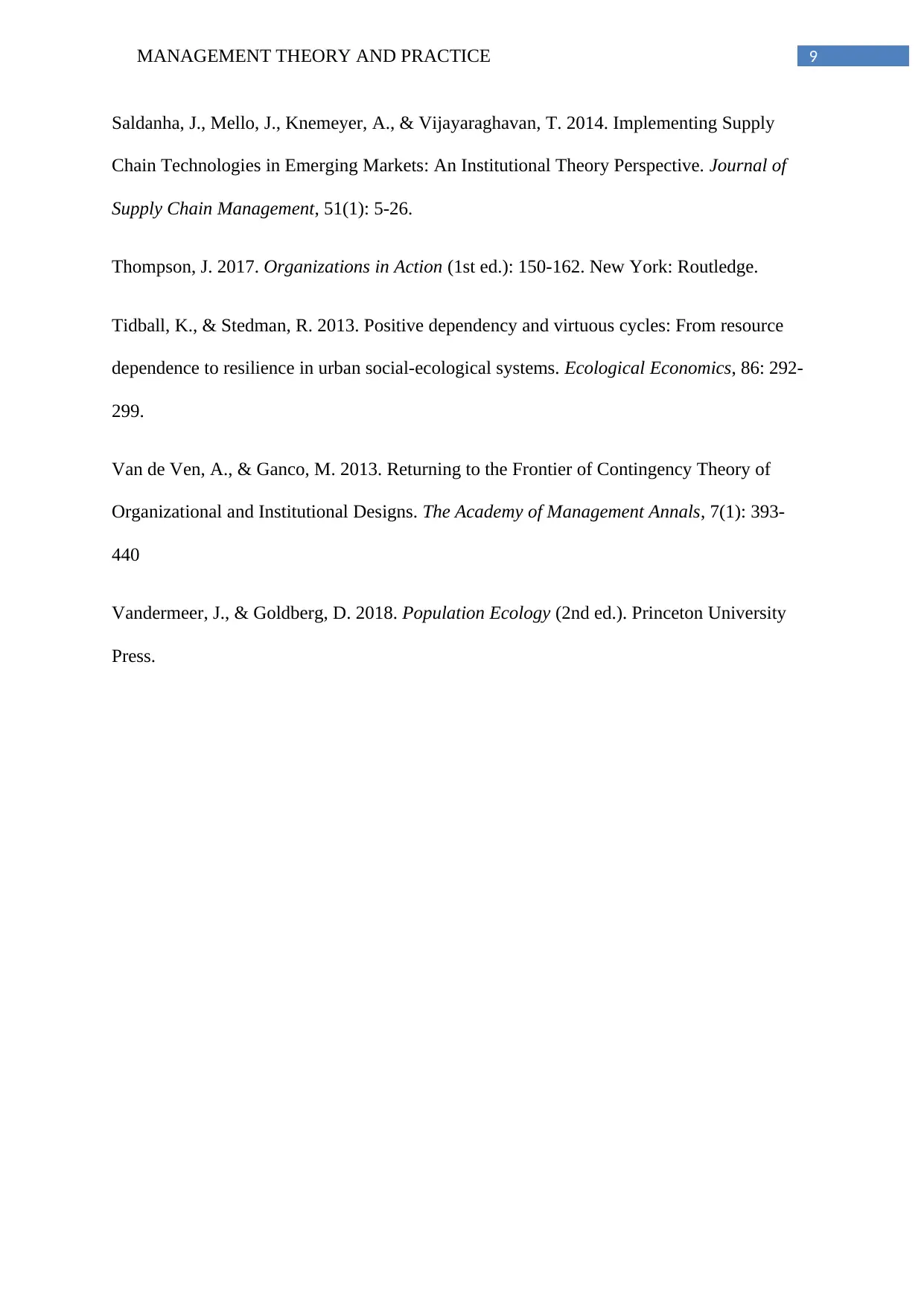
9MANAGEMENT THEORY AND PRACTICE
Saldanha, J., Mello, J., Knemeyer, A., & Vijayaraghavan, T. 2014. Implementing Supply
Chain Technologies in Emerging Markets: An Institutional Theory Perspective. Journal of
Supply Chain Management, 51(1): 5-26.
Thompson, J. 2017. Organizations in Action (1st ed.): 150-162. New York: Routledge.
Tidball, K., & Stedman, R. 2013. Positive dependency and virtuous cycles: From resource
dependence to resilience in urban social-ecological systems. Ecological Economics, 86: 292-
299.
Van de Ven, A., & Ganco, M. 2013. Returning to the Frontier of Contingency Theory of
Organizational and Institutional Designs. The Academy of Management Annals, 7(1): 393-
440
Vandermeer, J., & Goldberg, D. 2018. Population Ecology (2nd ed.). Princeton University
Press.
Saldanha, J., Mello, J., Knemeyer, A., & Vijayaraghavan, T. 2014. Implementing Supply
Chain Technologies in Emerging Markets: An Institutional Theory Perspective. Journal of
Supply Chain Management, 51(1): 5-26.
Thompson, J. 2017. Organizations in Action (1st ed.): 150-162. New York: Routledge.
Tidball, K., & Stedman, R. 2013. Positive dependency and virtuous cycles: From resource
dependence to resilience in urban social-ecological systems. Ecological Economics, 86: 292-
299.
Van de Ven, A., & Ganco, M. 2013. Returning to the Frontier of Contingency Theory of
Organizational and Institutional Designs. The Academy of Management Annals, 7(1): 393-
440
Vandermeer, J., & Goldberg, D. 2018. Population Ecology (2nd ed.). Princeton University
Press.
1 out of 10
Related Documents
Your All-in-One AI-Powered Toolkit for Academic Success.
+13062052269
info@desklib.com
Available 24*7 on WhatsApp / Email
![[object Object]](/_next/static/media/star-bottom.7253800d.svg)
Unlock your academic potential
Copyright © 2020–2025 A2Z Services. All Rights Reserved. Developed and managed by ZUCOL.





